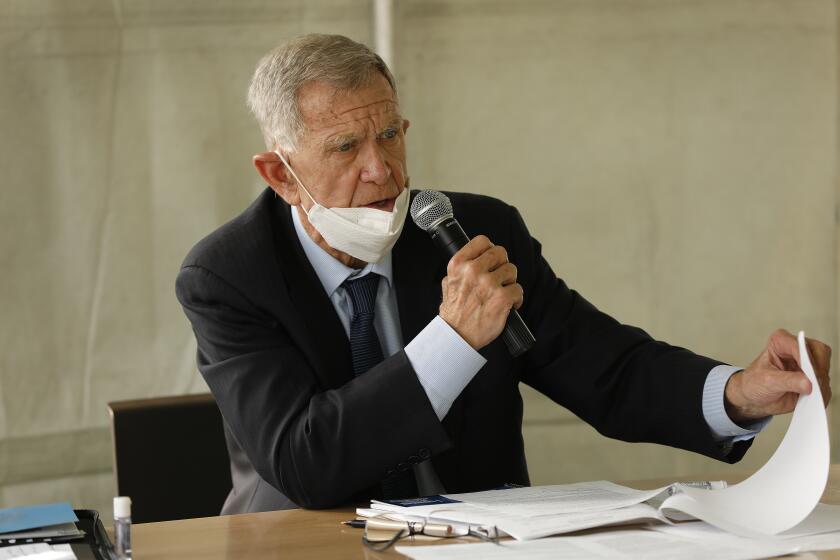Sunland-Tujunga comes to identity crossroads
- Share via
Sunland-Tujunga, long known as Los Angeles’ rural outpost of craggy canyons, secluded houses, horse trails and a onetime motorcycle gang hide-out, is in the midst of an identity crisis: Build a Home Depot or shop at a mom-and-pop hardware store? Hilltop McMansions or open space? Support a revitalized main street or promote more tract home developments?
“It’s at a crossroads,” Councilwoman Wendy Greuel said of the 6-mile-long, 2-mile-wide community cradled between the Verdugo and San Gabriel mountains. “It’s a moment where people are saying, ‘We want to control our own destiny.’ ”
But the challenge confronting city planners and lawmakers is how to balance the interests of residents, who relish their hideaway community, and many newcomers, who enjoy their spacious homes and aren’t necessarily opposed to growth. The most recent flare-up involves whether a Home Depot should be permitted to open on the site of a shuttered K-Mart, a decision under review by the Department of City Planning.
The proposal has become symbolic to many preservation-minded residents, who believe that the opening of a regional big-box store that caters to construction and home improvement signals a lamentable change: Their hideaway has been discovered, the era of canyon tranquillity may be ending.
“It just has to be protected, or the kids won’t be able to see any wildlife or flora,” said Elaine Brown, who lives near the Big Tujunga Wash -- a rocky, white plain that floods during heavy rains. “They won’t know what it’s like to be in the country. They’ll never see a horse.”
What Brown does see is the march of construction.
Over the three-year period that ended in June 2006, 365 housing permits were issued in Sunland-Tujunga. Though that number may not seem particularly startling, it represents a 317% increase over the previous three years and reflects the recent red-hot red estate market.
The growth comes to an area where for years the only “hot” feature was the weather. Sunland-Tujunga largely escaped the explosive growth in the late 1980s and ‘90s in neighboring Sylmar and Lake View Terrace. It had never been a prestige address in a region where foothill communities -- Chatsworth, La Canada-Flintridge, Bradbury, Glendale’s view homes -- generally command top-of-the-hill prices.
But in recent years a sense of community pride and activism has emerged among many Sunland-Tujunga preservationists, who have:
* Supported an ordinance written by Greuel, who represents the area, that restricts so-called “mansionized” homes in Sunland-Tujunga, an idea that lawmakers are considering extending citywide;
* Supported Greuel’s efforts to purchase more than 200 acres of undeveloped mountain land to protect it from development;
* Pursued plans to revitalize their neglected “downtown” along Commerce Avenue, which would include creating a shopping center with a plaza-like feel and two restaurants.
When Debi Statland talks about her neighborhood, she stresses how soothing it is to awaken each morning to the sounds of chirping quail and wailing coyote pups. “This is about the last refuge” in L.A., she said. “That’s all normal here, and I would like to stay that way.”
She was standing near a chain-link fence that surrounded the vacant K-Mart on Foothill Boulevard, as a few of her neighbors waved signs that read “No to Home Depot!” The group hoped that their protest would help overturn a decision by the city’s Building and Safety Department to allow renovations for the warehouse store. They argued that the center would attract day laborers and belching trucks.
Greuel, who has sided with the critics, said she would like a store that would “serve the community that lives here,” such as a Target. “They don’t want to see a vacant storefront,” Greuel said, “but they don’t want to see anything that’s just thrown at them.”
Kathryn Gallagher, a Home Depot spokeswoman, said that company research had showed that demand existed for the store in Sunland-Tujunga, and that it would be an anchor for a commercial area that had suffered since Kmart closed.
“We hope we will rejuvenate business in the area, and help economic growth,” Gallagher said. “Our research shows in Sunland-Tujunga, the percent of home ownership is high and prime, with additional growth going on in the area.”
Soledad Saris, a 31-year-old mother of three, was thrilled about the prospect of a Home Depot -- after all, she needs to paint her spacious new four-bedroom home.
“I’m just tired of everyone complaining of the houses being built so big. It is what it is,” said Saris, a transplant from Eagle Rock, of her two-story home. “Times change.”
Gene Ramirez, 19, a Pasadena City College student who has lived in Tujunga for seven years, said the Home Depot could be an employment gold mine for students.
“It’s 2007,” he said. “You can’t keep this place a small town anymore.”
As for bigger homes being built in the neighborhood, Kevin Johnson, 27, has no problem with that.
“If I want to build a big house, who are you to judge what I do?” said Johnson, who was born and raised in Tujunga. “If they didn’t want development, they should have kept everything dirt roads. The world is all about evolution. You can’t stop it.”
The community’s quirky past included the establishment in 1913 of a utopian sanctuary in which farmers worked collectively, apart from the “evils” of the big city. By the 1920s, Sunland had been absorbed by the city of Los Angeles, and Tujunga followed soon after -- Los Angeles wanted Tujunga for the water rights, and Tujunga needed firefighters. The enclave became known as Sunland-Tujunga.
In the 1930s and 1940s, small, weekend homes, perhaps 800 to 1,000 square feet, were built as hunting lodges or mountain retreats for the rich. Asthmatics flocked to the area for its fresh mountain air. And after World War II, the community attracted employees from the San Fernando Valley’s then-thriving aerospace industries.
The opening of the 210 Freeway in the 1970s made Sunland-Tujunga freeway-accessible. The community’s “main street,” two blocks of Commerce Avenue, lost local customers, who could drive to the mall. Later, apartment complexes sprung up along Foothill Boulevard.
Its “outback” reputation was cemented in the 1980s, when Sunland-Tujunga became a haven for motorcycle gangs, which were later run out by law enforcement. By the 1990s, Los Angeles police had dubbed Tujunga the speed capital of the San Fernando Valley for its methamphetamine-related arrests.
By 2000, the expanse of space within the city limits of land-starved Los Angeles became an attractive prospect for developers, who began tearing down the small, aging houses, subdividing large parcels and building huge homes on small lots to maximize profits.
“They’ll rip down the existing square feet and put in a big, huge house that they can sell for $800,000,” said Tomi Lyn Bowling, a Sunland real estate broker. “They end up pocketing half a million -- that’s why it became such a hot item. Housing up here used to be relatively cheap, but ... boy, it didn’t take long for [development] to spread like wildfire.”
Builder Robert Hall was proud to hold the match.
“I’m an entrepreneur. I build my houses, people buy them, and I earn my living,” said Hall, who lives a few mountains over, in La Crescenta. “I’m just a guy that builds houses that people like. To me, I improve this area.”
Standing in front of one of his two-story homes -- criticized by preservationists for its size -- Hall said his projects raised overall property values and brought needed housing to the city.
“The biggest problem is you have people who don’t like change. But it’s the future,” Hall said. “People have to live somewhere.”
But homes like Hall’s angered residents and sparked the 2005 anti-mansionization ordinance, which limits homes in Sunland-Tujunga to either 2,400 square feet or 40% of the lot’s square footage.
The ordinance hasn’t squelched construction. In La Tuna Canyon, 34 homes are rising next to a horse stable and an equestrian trail. Near Oro Vista Avenue and Big Tujunga Canyon Road, a developer hopes to build 20 homes.
But to some, a Home Depot represents the arrival of suburban convenience.
“It’s going to bring prices down, and it’s going to bring employment here,” said Michael Geer, 51, of Shadow Hills. Geer, who works in construction, fondly remembers his youth, when he rode horses in the canyons and foothills. But nowadays, he is more interested in riding motorcycles.
“It’s always been a rural area, and we would like to stay rural,” he said.
“But it’s inevitable. It’s part of progress. It’s not always my druthers, but I think we have to grow.”
More to Read
Sign up for Essential California
The most important California stories and recommendations in your inbox every morning.
You may occasionally receive promotional content from the Los Angeles Times.











